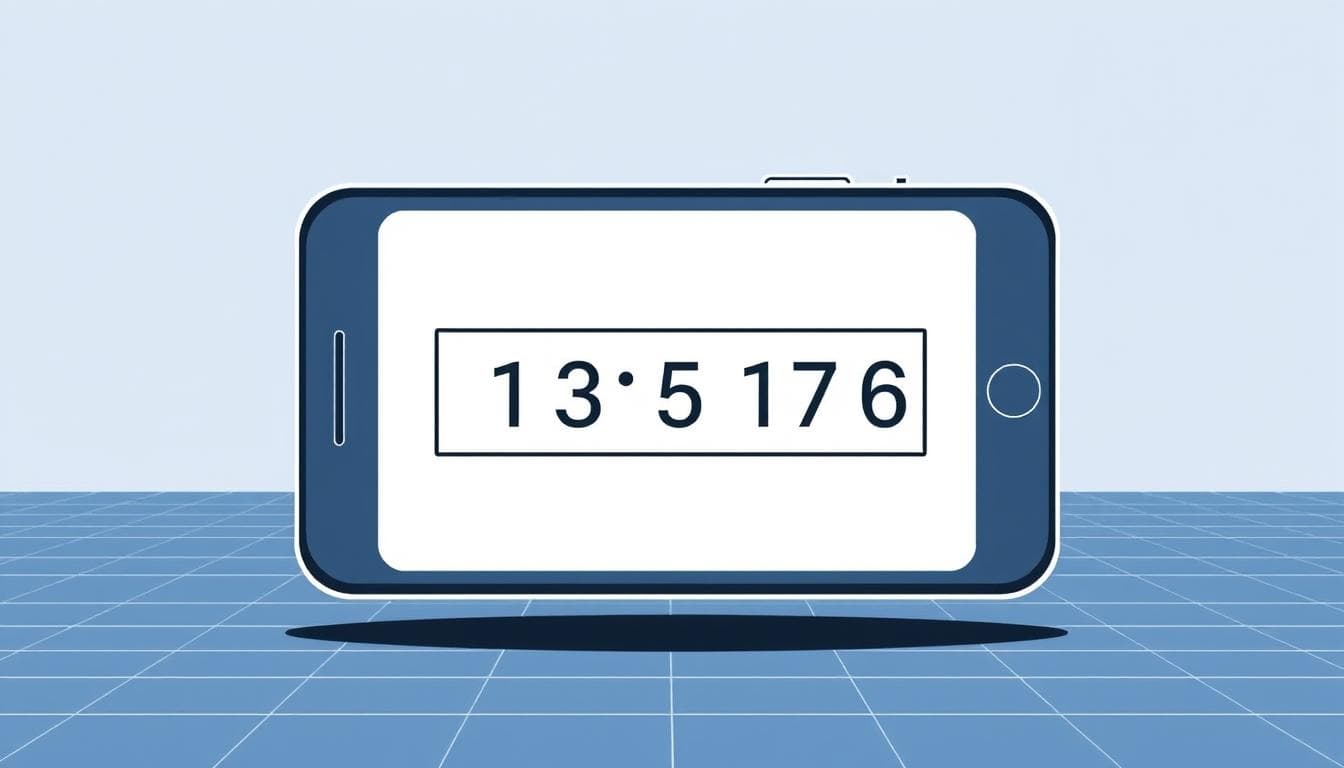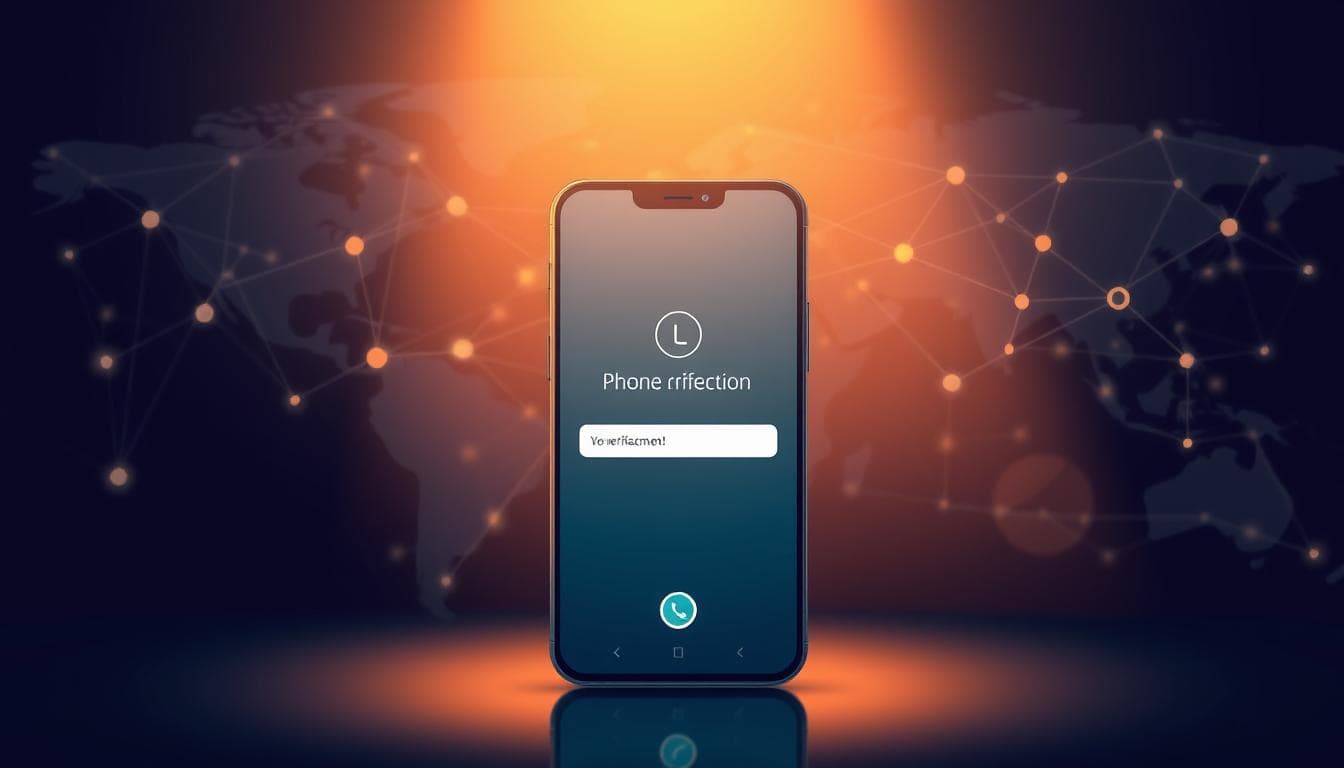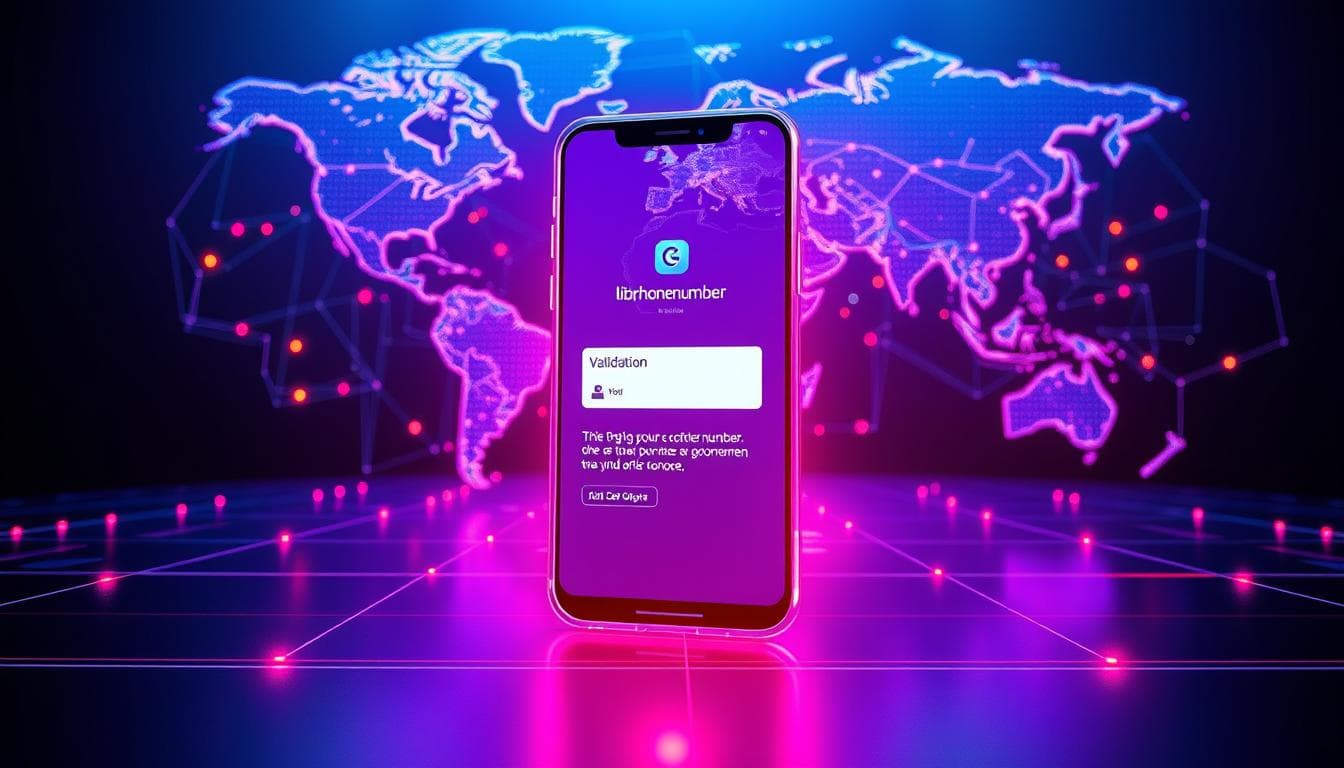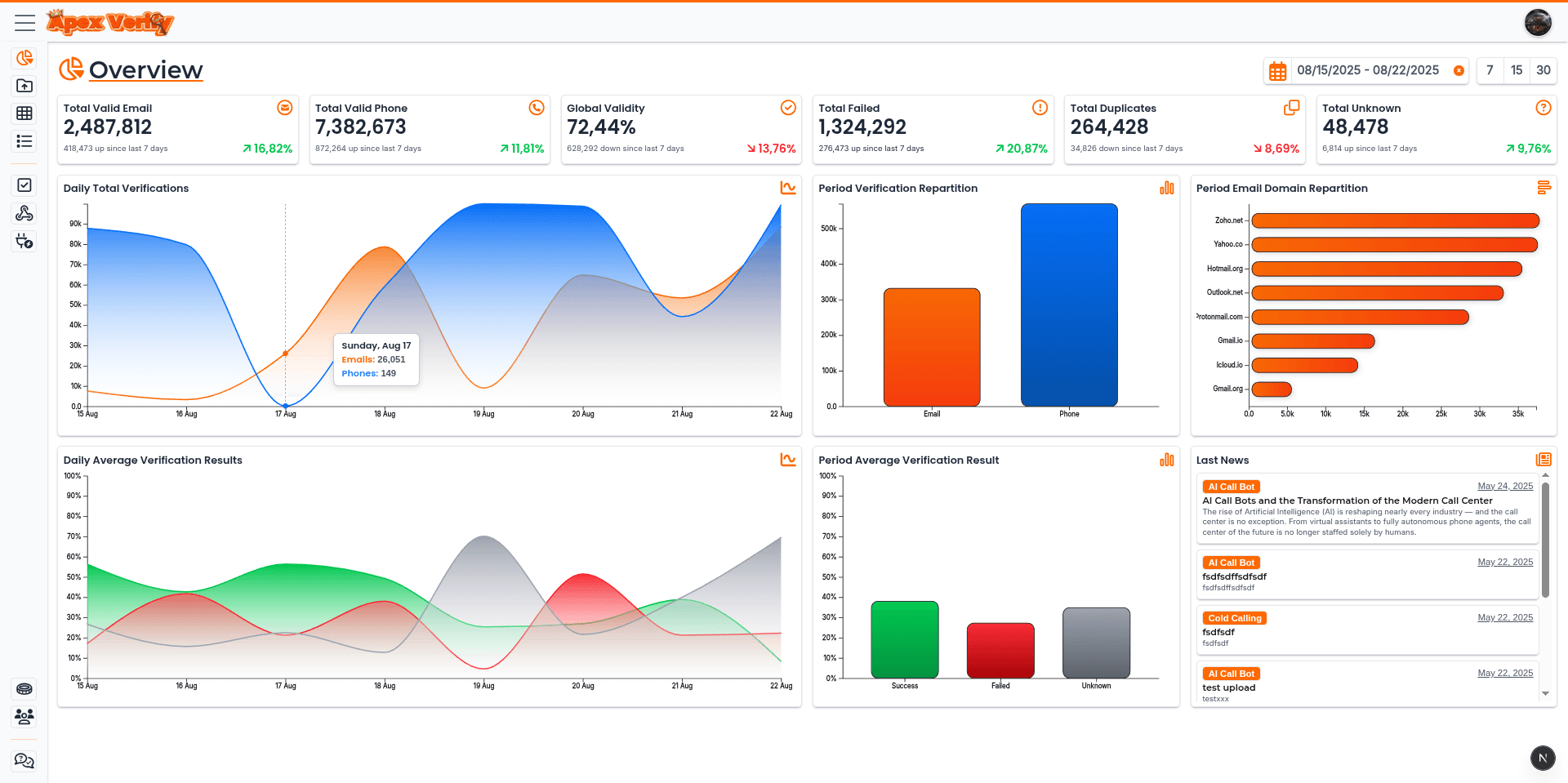What Is The Difference Between Phone Number Validation And Verification?
Are you losing customers because your messages never reach them? Many businesses struggle with contact database accuracy. They often confuse two critical processes.
Companies frequently interchange phone number validation and phone number verification. Yet, these are distinct processes with different roles in keeping contact databases clean.
Phone number validation verifies if a contact adheres to the correct format and structure. It ensures data quality by checking against E.164 standards and syntax rules at the entry point.
Phone number verification confirms active network connectivity. This process tests whether the contact can actually receive communications and verifies user ownership.

Understanding these differences is vital for businesses in SMS marketing, customer support, and fraud prevention. We'll dive into why you need both processes to enhance outreach effectiveness. This reduces wasted marketing spend and ensures compliance with telecommunications regulations.
Key Takeaways
- Validation checks format and structure while verification confirms real-world connectivity
- Both processes serve different purposes in maintaining accurate contact databases
- Validation ensures data quality at the entry point using E.164 standards
- Verification tests active network status and confirms user ownership
- Combining both methods improves delivery rates and customer engagement
- These processes are essential for SMS marketing and fraud prevention
- Understanding the distinction helps reduce wasted marketing spend
Understanding Phone Number Validation
Phone number validation is key to keeping contact databases clean in business operations. It acts as a gatekeeper, stopping wrong numbers from entering your systems. This early catch prevents communication failures and saves resources.
This process checks if phone numbers follow international standards before they're stored. It ensures numbers have the right structure for global routing. Without this check, businesses risk having useless contact info, harming marketing and customer outreach.
What Phone Number Validation Means
Phone number validation is the systematic examination of number formatting and structural components to ensure conformity with telecommunications standards. It verifies numbers follow syntax rules and include valid elements like country codes and area codes. Validation doesn't check if someone can answer the phone—it just checks if the number is formatted correctly.
The foundation of phone number validation is E.164 formatting standards, a universal structure for representing phone numbers globally. This standard ensures numbers can be recognized and routed across different countries and networks. Numbers in E.164 format include a country code, national destination code, and subscriber number in a sequence that telecommunications systems can interpret.
Format and syntax checks are at the heart of validation. These checks look for correct character types, proper punctuation, and length. We spot common mistakes like missing digits, extra spaces, or invalid special characters that prevent numbers from working in real-world systems.
How Validation Checks Format and Structure
The technical process of format checking involves parsing the number into its parts and analyzing each element. We use tools like google libphonenumber, an industry-standard library that provides detailed parsing for phone numbers worldwide. This library has extensive metadata about numbering plans, enabling accurate validation across different regions and systems.
Validation tools check multiple structural elements to determine format correctness. They break down the number to verify country code validity, assess area code legitimacy, and confirm digit sequences. This multi-layered approach catches errors that simpler methods might miss, ensuring only properly structured numbers enter your database.

Checking Number Length and Formatting
Number length validation ensures phone numbers have the correct digit count for their country and region. Different nations have varying length requirements, and validation systems check these against the number. A number that's too short or too long is invalid and would fail in actual communication.
We examine digit formatting to identify numbers that violate structural rules for their region. Validation checks verify the sequence of digits makes sense within the numbering plan of the associated country code. For example, certain digit combinations may be reserved for special services or prohibited from use in standard subscriber numbers, and validation catches these violations before they enter your system.
Validating Country Codes and Area Codes
Country code verification confirms the leading digits correspond to an actual nation recognized by international telecommunications standards. This check ensures the number can be properly routed through global networks. Invalid country codes immediately flag a number as unusable, preventing wasted communication attempts to non-existent destinations.
Area code validation examines regional prefixes to verify they're legitimate and currently in use within the specified country. Telecommunication authorities regularly update area code assignments, retiring obsolete codes and introducing new ones for growing regions. Our validation process references current area code databases to identify numbers using outdated or unassigned regional prefixes that would result in failed connection attempts.
Beyond basic format checking, modern validation systems can identify the line type associated with each number. This capability determines whether a number belongs to a mobile network, landline, or VoIP service. Understanding line type is critical for communication strategy—sending SMS messages to landlines wastes resources, while mobile network numbers support both voice calls and text messaging.
Tools like google libphonenumber provide line type detection as part of their validation suite. This feature helps businesses route communications through appropriate channels based on the number's capabilities. Knowing a number connects to a mobile network allows for inclusion in SMS marketing campaigns and two-factor authentication systems that rely on text message delivery.
Understanding Phone Number Verification
Verification goes beyond just checking if a phone number looks right. It confirms if the number is working and connected to a carrier network. This ensures real-world connectivity, not just format accuracy. It tests the telecommunications infrastructure to see if numbers can receive messages and calls.
Verification fills a gap that validation can't. A number might look perfect but be disconnected or reassigned. We need verification to check if a number works in real life.
What Phone Number Verification Means
Verification is an active test that checks if a number is live and reachable. It confirms a contact point is not just valid but can be reached. This involves talking to carrier databases and network systems in real time.
This method gives us real-time info on number availability. We can see if a subscriber is active or if the number is deactivated. This info is key for businesses needing reliable customer contact.
Marketing teams, customer service, and security systems all need to know their messages will get through. Verification helps reduce bounce rates and improve communication success.

How Verification Confirms Real-World Connectivity
We check real-world connectivity through various technical methods. Each method gives insights into number reachability and user control. The verification process combines telecom queries with user interaction for full confirmation.
Our verification starts with network status testing. We check carrier databases to see if a number is assigned to an active subscriber. This happens without needing the user to do anything.
HLR lookup technology is our main tool for network status checks. Home Location Register databases hold key subscriber info for mobile operators. We query these databases for real-time data on number status and network assignment.
An hlr lookup tells us if a number is active on a GSM network or other mobile tech. We can see if the subscriber is reachable, temporarily unavailable, or permanently disconnected. This method is cost-effective for checking large number lists without sending messages.
The hlr lookup process gives us several important data points:
- Network availability: If the number is active and connected to a carrier network
- Carrier information: The telecom provider managing the number
- Roaming status: If the subscriber is using their home network or roaming
- Number portability: If the number has been transferred between carriers
We value this method because it verifies without interrupting the user. The GSM network allows these queries to happen instantly, giving results in seconds. This makes it perfect for pre-screening large contact databases.
Confirming User Ownership
Knowing a number's status doesn't mean the right person controls it. We need more to confirm user ownership and ensure the person using the service is the account owner.
Flashcall verification is a new solution that balances security with ease. We make a brief automated call to the number. The user doesn't need to answer or enter codes. Our system detects the call and gets verification info from the caller ID.
This flashcall method is seamless because users just need their phone nearby. We confirm ownership by verifying the device receives our call, proving both connectivity and possession. The whole process usually takes just a few seconds.
Traditional verification methods are also valuable for full confirmation:
- SMS verification: We send a one-time password via text message that users must enter to confirm access
- Voice call verification: We place an automated call that delivers a verification code verbally
- Missed call verification: We call from a specific number and verify when the user reports receiving it
These methods verify number activity and user access. They confirm the number is active and the user has the device, providing identity and connectivity verification.
SMS verification is the most common method because it's widely compatible and easy to use. We send a unique code that expires soon. Users enter the code to complete verification.
Voice call verification is a reliable alternative when SMS fails. We deliver codes through automated voice messages that work on any phone. This is great for landline verification or areas where SMS is unreliable.
The mix of network status testing and user confirmation gives us total confidence in our verification results. We know verified numbers are active and in the right hands.
Phone Number Validation vs Verification: Key Differences
Many businesses often confuse phone number validation and verification. These processes differ in scope, technology, and resource investment. While both phone number validation and phone number verification improve data quality, they serve different stages and purposes in your communication workflow. Understanding these differences is key to effectively allocating resources and choosing the right approach for your business needs.
We will explore three fundamental dimensions that separate these processes. Each dimension highlights why businesses need both approaches, not just one.

Scope and Purpose Differences
Phone number validation acts as a preventive filter against data quality issues. It checks if a number is correctly formatted according to telecommunications standards. This process examines the number's structure without making external connections.
It verifies if the number follows the rules for its country and region.
On the other hand, phone number verification confirms actual connectivity and reachability in real-world networks. It answers the question: "Can we successfully deliver messages to this number right now?"
The purpose distinction becomes clearer when we consider error detection rates. Validation identifies 50-60% of phone number issues during initial data entry. Verification then catches an additional 20-30% of problems that validation cannot detect, such as disconnected numbers that maintain proper formatting.
Technical Process Differences
The technical mechanisms behind these processes differ fundamentally. Phone number validation operates as a static analysis system that requires no external network connections. It uses algorithmic pattern matching and reference databases to check numbers against known telecommunications standards.
This validation process includes several components:
- Country code verification against international numbering plans
- Length validation based on regional specifications
- Format checking for proper digit arrangements
- Number type identification (mobile, landline, VoIP)
Phone number verification employs dynamic testing methods that interact with live telecommunications infrastructure. These real-time checks require actual network queries or test communications. The verification system connects to carrier databases and network elements to confirm current status.
We execute verification through multiple technical approaches. HLR (Home Location Register) lookups query carrier databases directly. SMS and voice call methods send actual test messages to confirm delivery capability.
The sequential nature matters significantly. Validation always comes before verification in an optimized workflow. There's no value in verifying a number that fails basic format requirements.
Cost and Time Implications
Resource requirements create another major distinction between these approaches. Phone number validation operates with minimal cost and exceptional speed. Most validation checks complete in milliseconds because they only require computational processing and database lookups.
The cost structure for validation remains remarkably low. We typically pay fractions of a cent per check, sometimes even less with bulk processing. This efficiency makes validation perfect for high-volume, real-time scenarios like web form submissions or mobile app registrations.
Phone number verification carries higher operational costs. Each verification requires network queries or actual message delivery, which incurs carrier fees. Processing times extend to several seconds per number due to network latency and response times.
Cost variations for verification depend on the method selected:
- HLR lookups: Generally 0.5-2 cents per query
- SMS verification: 1-5 cents per message depending on destination
- Voice call verification: 2-10 cents per call based on geography
- Flashcall methods: Similar to SMS costs but faster execution
These cost differences directly impact business strategy. We recommend validation for continuous data entry monitoring where immediate feedback prevents bad data accumulation. Verification becomes cost-effective for periodic database cleaning, pre-campaign scrubbing, or critical registration flows where confirming actual reachability justifies the investment.
The time investment extends beyond processing speed to include implementation complexity. Validation systems integrate quickly with minimal infrastructure requirements. Verification systems need carrier relationships, API integrations, and more sophisticated error handling mechanisms.
How Phone Number Validation Works
Modern phone number validation systems use advanced parsing libraries and numbering plan databases. They verify format correctness in milliseconds without contacting telecom networks. This makes it a fast and cost-effective way to prevent bad data from entering your systems.
Syntax validation is the first step in this process. It checks if numbers follow proper formatting rules and comply with E.164 international dialing standards. This ensures phone numbers have a consistent structure worldwide.
Country code verification is the next critical layer. The validation engine checks if the number corresponds to a legitimate geographic region. This prevents fake entries with non-existent country codes.
Using Google libphonenumber for Format Checking
The google libphonenumber library is the industry standard for parsing and validating telephone numbers globally. Google developed and maintains this open-source tool to handle international phone number formats. It's trusted by organizations worldwide for its detailed metadata on every country's numbering plan.
This powerful resource supports various programming environments. Developers can use it in Java, JavaScript, Python, C++, and more. Its flexibility makes it accessible across different technical stacks.

Implementing libphonenumber Library
Starting with google libphonenumber is straightforward. Developers install it through their preferred package manager. The integration process varies slightly by programming language but remains consistent in functionality.
Once installed, the library offers essential validation functions. These include parsing phone numbers, formatting them according to regional conventions, and verifying their structural validity. The metadata database updates regularly to reflect changes in national numbering plans.
The library handles edge cases automatically. It accounts for special numbering arrangements, premium rate services, and emergency numbers. This eliminates the need for custom validation logic for each country.
Phone numbers come in various formats due to user input habits. Some include country codes, while others omit them. The google libphonenumber library can interpret all these variations.
The parsing function normalizes diverse inputs into standardized formats. It converts numbers like "(202) 555-1234" or "202-555-1234" or "2025551234" into a consistent E.164 format. This ensures consistent processing across different systems and databases.
E.164 format represents phone numbers as a string of digits with a plus sign and country code prefix. For example, a Washington, D.C. number becomes +12025551234 in this format. This canonical representation ensures consistent processing across different systems and databases.
The library distinguishes between local and international notation automatically. When users enter numbers without country codes, the system can infer the appropriate prefix based on the default region setting. This smart parsing reduces user friction during data entry.
Validating Country Codes and Number Length
Country code validation involves confirming that the prefix corresponds to an actual country or territory. The validation engine cross-references the code against the official ITU-T E.164 assignment list. This prevents numbers with invented prefixes from passing validation.
Number length verification is a more nuanced challenge. Different countries enforce different digit count requirements based on their telecommunications infrastructure. Some nations use fixed-length numbers, while others allow variable lengths.
The validation process checks whether the total digit count matches expected patterns for the specific country and region. For instance, mobile network numbers in the United States always contain 10 digits after the country code. European countries often have more flexible length requirements depending on the city or carrier.
Area code and network prefix validation adds another layer of scrutiny. The system verifies that these digits fall within currently assigned ranges. Telecommunications regulators periodically release new prefixes as demand grows, so validation databases must stay current.
This multi-step verification catches a significant percentage of data entry errors. Typos that create impossible number lengths get flagged immediately. Numbers using outdated or unassigned prefixes also fail validation, protecting your database quality.
Identifying Number Types: Mobile, Landline, and VoIP
Modern validation systems classify numbers by service type through prefix pattern analysis. Telecommunications regulators assign specific number ranges to different service categories. This systematic allocation makes it possible to determine whether a number connects to a mobile network, landline, or voip service.
The classification process examines the digits following the country code. In many countries, mobile network numbers begin with distinctive prefixes that differ from those assigned to fixed-line services. For example, UK mobile numbers typically start with 7, while landline numbers use geographic area codes.
Distinguishing between service types provides critical business intelligence. SMS marketing campaigns benefit enormously from filtering out landline numbers, which cannot receive text messages. Sending SMS to landlines wastes message credits and skews campaign analytics.
The differences between service types include:
- Mobile numbers: Support SMS and voice calls, typically associated with individual users, higher engagement rates for marketing
- Landline numbers: Voice-only capability, often associated with businesses or households, useful for voice campaigns
- VoIP services: Internet-based telephony, variable reliability, may indicate tech-savvy users or business operations
- Premium rate: High-cost services that should typically be excluded from standard communications
Voice campaign strategy also benefits from number type identification. Knowing whether you're calling a mobile network versus a landline informs optimal contact timing. Mobile users typically answer calls throughout the day, while landline contacts often reflect business hours availability.
The ability to filter by service type before initiating contact saves significant costs. VoIP numbers may have different routing charges compared to traditional telephony. Premium rate numbers should generally be excluded from standard business communications to avoid unexpected expenses.
We implement this classification at the validation stage to segment contact lists effectively. Clean, properly categorized phone number data enables more targeted communication strategies. This precision improves both customer experience and campaign return on investment.
How Phone Number Verification Works
Modern phone number verification uses advanced technologies to check if a number is active and reachable. It goes beyond simple checks by connecting with telecommunications systems. We look at three main verification technologies used by businesses to confirm if a number is connected and active.
HLR Lookup Technology for Network Verification
The hlr lookup method is the most advanced verification technique today. It accesses the Home Location Register, a database maintained by mobile network operators. This database provides detailed information about phone number status and network capabilities.
Querying Mobile Network Databases
The hlr lookup process connects to carrier databases through special protocols. These include SS7 and Diameter protocols, allowing verification services to query network operators directly.
Initiating an hlr lookup query retrieves key data points. These include network status, subscriber identity, location area, and services enabled for the number. The response confirms if the number is active, roaming, and can receive SMS and voice calls.
This query also identifies the current carrier of the number. This is vital for ported numbers that have changed providers. Businesses gain insights to optimize communication strategies and reduce failed delivery attempts.
The hlr lookup technology shows which mobile network generations a subscriber's device and account support. This is important for businesses planning communication campaigns across different networks.
Network evolution has moved through several generations. It started with gsm (2G), then 3g (third generation) introduced mobile data services. Now, we have 4g LTE and 5g (fifth generation) networks. 6g networks are in development, promising even more capabilities.
Knowing which network generations a phone number supports helps businesses make informed decisions. Different generations offer varying messaging capabilities and data speeds. This information helps tailor communication methods to maximize successful engagement with subscribers.
Flashcall Verification Methods
The flashcall approach is popular for its superior user experience. It streamlines the authentication process while maintaining high security standards.
How Flashcall Technology Works
The flashcall verification system initiates a brief automated call to the user's phone number. The call contains specific verification information. The user's device receives the call notification without needing to answer.
The application automatically reads the caller ID to extract the verification code. This process eliminates the need for manual input. The system completes authentication within seconds, providing a seamless experience.
This method requires permission to read phone state information. Some countries or carriers may restrict flashcall availability. Despite these limitations, it works reliably in most major markets worldwide.
Benefits for User Experience
The flashcall method offers several advantages over traditional SMS verification. Users experience immediate authentication without waiting for message delivery. This can take seconds to minutes depending on network conditions.
The process eliminates the need for users to switch between applications to retrieve codes. This reduction in friction accelerates registration and login flows significantly. Conversion rates typically improve when businesses implement flashcall verification because users encounter fewer obstacles.
Cost considerations also favor flashcall in many markets. The brief call duration often results in lower expenses compared to SMS delivery charges. Businesses benefit from both improved user satisfaction and reduced operational costs when deploying this verification method.
SMS and Voice Call Verification
Traditional verification methods using SMS and voice calls are widely adopted across industries. These proven techniques provide reliable authentication while confirming active line status simultaneously.
Sending One-Time Passwords
The system generates time-limited verification codes when users request authentication. These one-time passwords (OTPs) are delivered via SMS message or automated voice call. Users must enter the received code within a specified timeframe to confirm they control the phone number.
SMS delivery typically occurs within seconds under normal network conditions. Voice calls provide an alternative when SMS delivery fails or when users prefer audible code delivery. Both methods create a secure authentication channel that verifies phone number ownership.
The codes expire after a predetermined period, usually between 5 and 10 minutes. This expiration window balances security requirements with user convenience. We implement rate limiting to prevent abuse and protect against automated attacks targeting the verification system.
Confirming Active Line Status
SMS and voice call verification inherently confirm that the phone number is active and connected to the network. Successful delivery proves the number can receive communications in real-time. This dual-purpose functionality makes these methods valuable for both verification and authentication objectives.
When an SMS delivers successfully or a voice call connects, we gain certainty about the number's current operational status. This confirmation helps businesses maintain clean contact databases by identifying disconnected or inactive numbers. Marketing teams can optimize campaigns by focusing resources on verified, reachable subscribers.
These traditional methods work universally across all carriers and countries. The widespread compatibility ensures consistent verification experiences regardless of geographic location or network operator. Security-conscious registration and transaction workflows continue to rely on these proven verification techniques for their reliability and extensive network coverage.
When to Use Validation vs Verification
In various scenarios, either validation or verification is more beneficial for achieving business goals. Understanding which method suits your needs is key to improving data quality. Both processes have unique advantages, depending on your operational context, budget, and accuracy needs.
Choosing the right approach involves evaluating several factors. These include the data collection stage, the need for real-time confirmation, and available resources for data processing. Let's examine the scenarios where each method excels.
Best Use Cases for Phone Number Validation
Phone number validation excels when format accuracy is critical and immediate feedback is beneficial. It's ideal for quick, cost-effective checks that prevent obviously incorrect data from entering your systems.
Data Entry and Form Submissions
Implement phone number validation at every point where users enter contact information. Web forms, mobile app registration screens, and customer service portals benefit from real-time validation that catches formatting errors instantly.
This method provides immediate feedback on incorrect numbers. Users see helpful error messages before submitting the form, reducing frustration and form abandonment rates.
Validation at the point of capture ensures only structurally sound numbers reach your database. It catches common mistakes like missing digits, incorrect country codes, and invalid number patterns that would require manual correction later.
Periodic data hygiene efforts rely heavily on validation to identify malformed numbers in existing contact databases. When you inherit legacy data or merge multiple contact lists, validation quickly flags entries needing attention.
This process standardizes number formats across your entire system. Consistent formatting improves reporting accuracy and ensures smooth integration with other business tools.
Validation also serves as a cost-effective preliminary filter before running more expensive verification processes. By eliminating obviously invalid entries first, you reduce the number of verification checks needed, optimizing your budget allocation.
Best Use Cases for Phone Number Verification
Phone number verification is essential when confirming active connectivity justifies the additional investment. It proves invaluable in situations where reaching real, active numbers directly impacts business outcomes and security.
Account Registration and Security
User authentication workflows depend on verification to establish trusted communication channels. When new users register for accounts, verification confirms they actually control the phone numbers they provide.
This confirmation prevents fraudulent account creation and reduces bot registrations significantly. Malicious actors find it much harder to create fake accounts when they must verify access to legitimate phone numbers.
Verification enables robust two-factor authentication systems that protect sensitive transactions. We use verified numbers for password resets, security alerts, and transaction confirmations, knowing these messages will reach the intended recipients.
Many industries face Know Your Customer regulations requiring identity verification. Phone number verification helps businesses comply with these requirements while establishing secure customer relationships.
Phone Marketing Campaign Optimization
Marketing teams achieve dramatically better results when they verify contact lists before launching campaigns. Phone marketing performance improves substantially when you remove disconnected and inactive numbers from your sending lists.
Verification scrubbing prevents wasted message credits on numbers that cannot receive communications. This protection also safeguards your sender reputation, which carriers monitor closely when determining message deliverability.
Identifying which numbers can receive SMS versus which are landlines requiring voice calls enables proper message routing. This segmentation ensures your communications reach recipients through the appropriate channel.
Campaigns using verified lists typically achieve 15-30% higher delivery rates compared to unverified lists. This improvement translates directly to better engagement metrics and stronger return on investment for phone marketing initiatives.
Combining Both Methods for Maximum Accuracy
Businesses achieve superior results when they integrate both validation and verification into their data management workflows. This combined approach leverages the strengths of each process while minimizing their individual limitations.
Creating a Two-Step Validation Process
We recommend implementing a staged workflow that applies validation first, then verification second. This sequence optimizes both cost-efficiency and data quality outcomes.
The first stage applies phone number validation to check format and structure immediately. This quick assessment eliminates malformed numbers before any expensive verification checks occur.
The second stage applies phone number verification only to numbers that passed initial validation. This approach confirms active status and reachability for entries that already meet structural requirements.
This two-step process prevents spending money on verification checks for numbers that validation would immediately flag as invalid. The cost savings become substantial when processing large contact databases with thousands of entries.
Maintaining Clean Contact Databases
Ongoing data hygiene practices require establishing consistent validation and verification schedules. Validation should occur at every new entry point, catching errors before they enter your systems.
We recommend running quarterly verification sweeps on existing databases to identify numbers that have disconnected. Phone number status changes over time as users switch carriers, abandon lines, or change numbers.
Implement suppression lists for verified inactive numbers to prevent wasting resources on future communications. These lists ensure your marketing efforts focus only on reachable contacts.
Tools like LandlineRemover provide both validation and verification features in a single platform. These integrated solutions enable complete phone number verification while obtaining details about line types for proper segmentation.
Businesses using both methods together typically maintain database accuracy rates above 95%, compared to 70-85% for those using only one method or neither. This superior accuracy translates to better campaign performance, reduced costs, and stronger customer relationships built on reliable communication channels.
Conclusion
Phone number validation and verification are essential for maintaining accurate contact databases. Validation checks the format and structure of numbers to catch errors early. Verification, on the other hand, confirms if a number is active and can receive messages.
While each tool is vital, they are not enough on their own. Validation can't identify disconnected numbers that appear correct. Verification, in turn, is a waste on numbers that validation has already flagged.
Our advice is to use both methods together. Validate numbers as soon as they're entered to prevent bad data. Then, verify them before sending messages, focusing on campaigns where delivery is critical. Also, perform verification sweeps every quarter to find inactive numbers.
The benefits to your business are clear. Clean databases lead to higher success rates, often reaching 90% compared to 70-80% for unverified lists. This means lower costs for communication and a better reputation with carriers. Customers also benefit from fewer failed attempts to contact them.
In today's mobile-centric world, where phone numbers are key identifiers, proper validation and verification pay off. These practices boost revenue, improve operational efficiency, and enhance customer satisfaction.
Frequently Asked Questions
What is the main difference between phone number validation and verification?
Validation checks if a number follows correct formatting standards. Verification confirms the number is active and reachable. Use validation to prevent errors and verification before campaigns to ensure numbers are active.
Can I use google libphonenumber for both validation and verification?
How does HLR lookup work for phone number verification?
What is flashcall verification and how does it compare to SMS verification?
Should I validate or verify phone numbers during user registration?
Why does identifying number types (mobile, landline, VoIP) matter?
How often should I verify my existing contact database?
What is E.164 format and why is it important for validation?
Can phone number verification detect if a number is on a Do Not Call registry?
What causes phone number validation to fail even when a number looks correct?
Is phone number verification required for compliance with data protection regulations?
What's the difference between validating mobile network numbers and landline numbers?
Can I validate phone numbers without an internet connection?
What happens if I skip validation and only use verification?
How does verification work for VoIP numbers versus traditional mobile networks?





